Ask a question from expert
Report on Structural Optimization of Aircraft Delta Wings
24 Pages2569 Words260 Views
Added on 2020-04-21
Report on Structural Optimization of Aircraft Delta Wings
Added on 2020-04-21
BookmarkShareRelated Documents
Structural optimization of aircraft delta wings 1STRUCTURAL OPTIMIZATION OF AIRCRAFT DELTA WINGSBy NameCourseInstructorInstitutionLocationDate

Structural optimization of aircraft delta wings 2 IntroductionAirplane wings refer to an appendage having a surface which is responsible for producinga lift that sequentially helps in the lift. The delta wing can be described d as a wing that when it is viewed from an aerial position, it has the shape of a triangle usually with the tip chopped off. The tip sharply sweeps in the backward direction with the front angle usually at sixty degrees whereas the rear angle being at ninety degrees. These type of wings do not have the horizontal stabilizers and they are most preferred in the supersonic aircraft due to their high-performance efficiency. The aim of this experiment is to give better structural parameters for the better airplane performance and safety of fighter aircrafts. Besides, the objective of the research is to perform structural optimization of the delta wing design by varying the elements and their properties[ CITATION Fed09 \l 1033 ].RoadmapThere is a different type of aircraft wings. They include Swept wing Delta wing Straight wing Besides, the wings can be positioned differently, for instance, we have parasol positioning, high mount positioning, and mid mount positioning and low mount positioning as illustrated
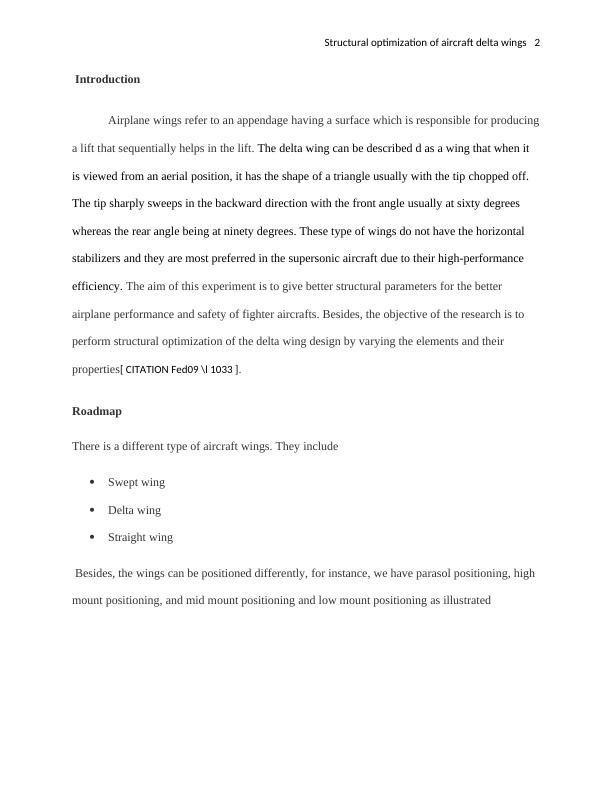
Structural optimization of aircraft delta wings 3Delta wings There are various types of delta wings which includes The tailless delta which is the type of delta wing having the wings in fell out a position asa result of undesired features and high drag effects. They are generally best for high altitude, high speed, and interceptor roles The tailed delta – this has an additional horizontal tail surface for the purposes of enhancing the performance[ CITATION Dir15 \l 1033 ]Cropped delta – this has its tip chopped off to help in avoiding effects of drag at high angles of attack Other types of delta wings include the compound delta, ranked arrow and the oval delta. These have their inner parts possessing enhanced sweepback than the outer parts to help in developing a high lit vortex and minimize the drag as shown below
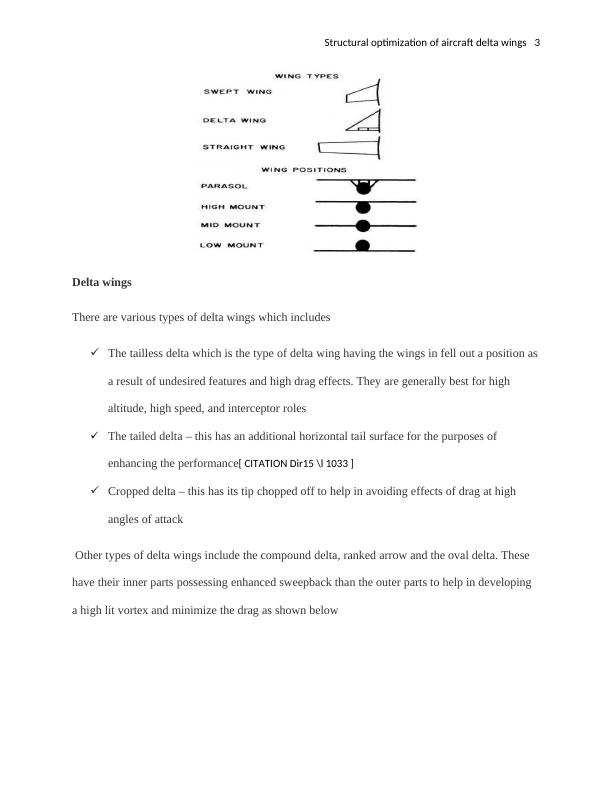
Structural optimization of aircraft delta wings 4Benefits of the delta wings I.The delta wings are physically attractive more so for the supersonic aircrafts. This is because the delta wings have a bigger root chord wing which is able to combine both the thick wing spar and relatively low thin wing spar which overall maintains the wave drag don and make the wing attractive II.The delta wing possesses a high internal volume of fuel as a result to the large root chord especially during low thickness[ CITATION Tom09 \l 1033 ]III.Besides the belt wing helps in lessening the speed of the aircraft due to its large surface area which is provided by the big sized root chord IV.Also, the delta wing produces a sufficient amount of edge sweep thereby resulting in vortex lift V.Naturally, the stability of the delta wing is desirable thereby eliminating the need for a separate tail surface VI.The delta wings are able to fly at very high angles of attack, thereby they are ideal to be used in the fighter jets VII.The delta wings have low-speed characteristics hence they are the best in terms of their overall performance when compared to others thereby being suitable for application in the supersonic airplanes
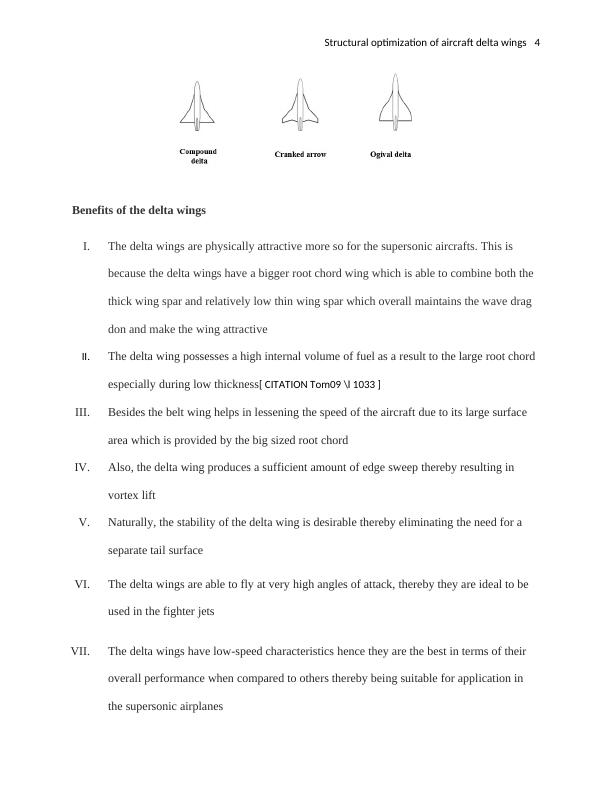
Structural optimization of aircraft delta wings 5VIII.Finally, the delta wings offer a desirable amount of drag during the landing of the supersonic aircraft. During incidences of landing, there is need for increasing the drag around the aircraft helps the delta wings aids in this more than the other types of wings Research gaps and limitations While delta wings are critical to achieving high lift for supersonic flight, they have some gaps and limitations which should be keenly taken care of. These research gaps include Insufficient stability at high angles of attack Production of excessive drag[CITATION DIA06 \l 1033 ]Limitations The delta wings necessitate for high landing takeoff speeds which is extremely dangerous Usually, the delta wings produces excess viscous drag at the same amount of lift when compared against the wing aspect ratio this is not desirable and in most cases, the swept wings are better in this aspect It is not possible to incorporate some devices which pose high lift characteristics such as fowler flaps into the delta wings. This is because the increased thickness of consistent airliner wings provides for easy integration of the flaps, while the backward edge of the delta wing creates unbearable pitching moments when such wing flaps get deflected
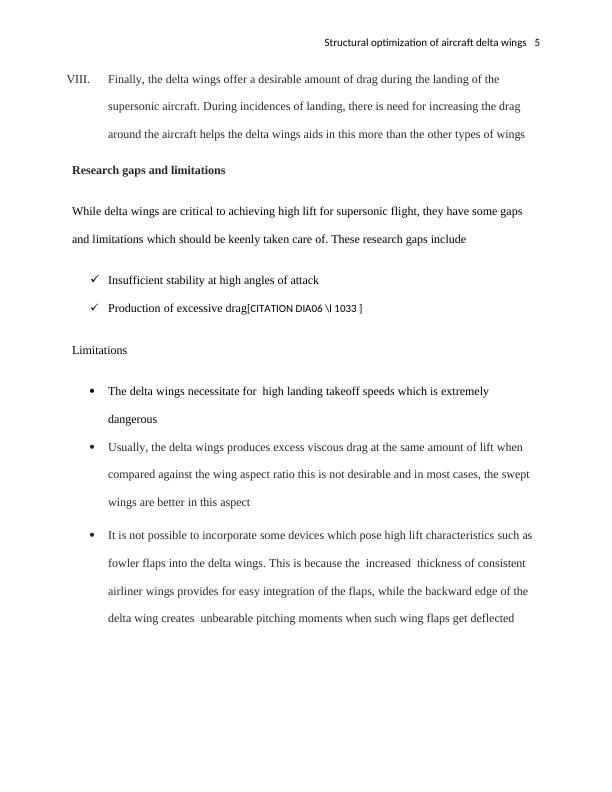
Structural optimization of aircraft delta wings 6Evolution of the delta wings The delta wing can be described d as a wing that when it is viewed from an aerial position, it has the shape of a triangle usually with the tip chopped off. The tip sharply sweeps in the backward direction with the front angle usually at sixty degrees whereas the rear angle being at ninety degrees. These type of wings do not pose the horizontal stabilizers and they are most preferred inthe supersonic aircraft due to their high-performance efficiency[ CITATION Tim09 \l 1033 ].The evolution of delta wings traces back in the year 1867 where we have the first design patented by two Englishmen J.W. Butler and E. Edwards. The design of the aircrafts would have flown if it ever took into account some components including the thrust, propulsion system, steam, gunpowder, steam, and jet. However, this design was not taken seriously until the start of the Second World War Later in the year 1940, a German professor by the name Alexander began doing a research on supersonic airplanes and took the delta shape as a case study .together with other researchers, they later developed a glider system and sent it to the United States for further research.
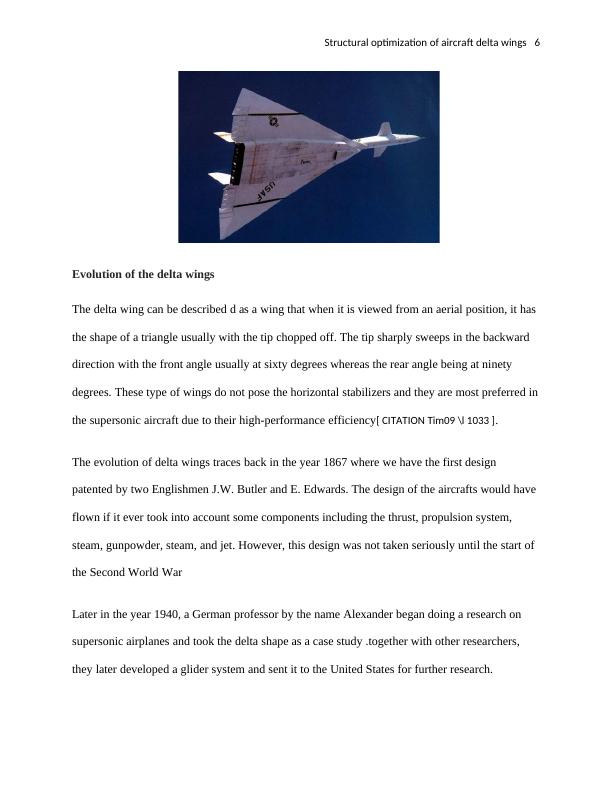
End of preview
Want to access all the pages? Upload your documents or become a member.